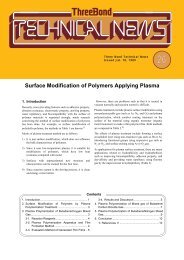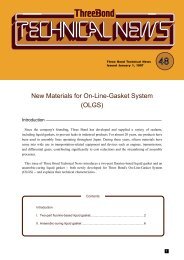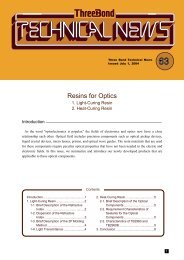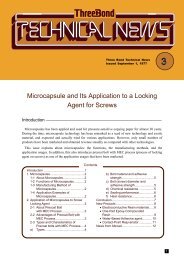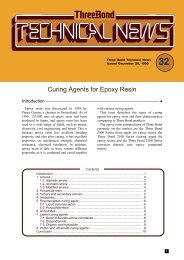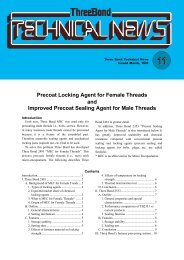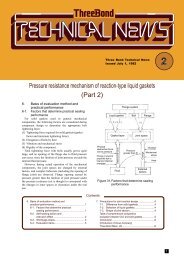Microcapsule and Its Application to a Locking Agent for Screws
Microcapsule and Its Application to a Locking Agent for Screws
Microcapsule and Its Application to a Locking Agent for Screws
Create successful ePaper yourself
Turn your PDF publications into a flip-book with our unique Google optimized e-Paper software.
Three Bond Technical News<br />
Issued September 1, 1977<br />
<strong>Microcapsule</strong> <strong>and</strong> <strong>Its</strong> <strong>Application</strong> <strong>to</strong> a <strong>Locking</strong><br />
<strong>Agent</strong> <strong>for</strong> <strong>Screws</strong><br />
Introduction ________________________________________________<br />
<strong>Microcapsule</strong>s has been applied <strong>and</strong> used <strong>for</strong> pressure-sensitive copying paper <strong>for</strong> almost 30 years.<br />
During the time, microcapsule technology has been remarked as a seed of new technology <strong>and</strong> exotic<br />
material, <strong>and</strong> expected <strong>and</strong> actually tried <strong>for</strong> various applications. However, only small number of<br />
products have been marketed <strong>and</strong> obtained revenue steadily as compared with other technologies.<br />
This issue explains about microcapsules: the functions, the manufacturing methods, <strong>and</strong> the<br />
application usages. In addition, this also introduces precoat bolt with MEC process (process of locking<br />
agent on screws) as one of the application usages that have been marketed.<br />
Introduction ...............................................1<br />
1. <strong>Microcapsule</strong>s ........................................2<br />
1-1 About <strong>Microcapsule</strong>s.........................2<br />
1-2 Functions of <strong>Microcapsule</strong>s ............2<br />
1-3 Manufacturing Method of<br />
<strong>Microcapsule</strong>s.................................2<br />
1-4 <strong>Application</strong> Examples of<br />
<strong>Microcapsule</strong>s.................................2<br />
2. <strong>Application</strong> of <strong>Microcapsule</strong>s <strong>to</strong> Screw<br />
<strong>Locking</strong> <strong>Agent</strong> .......................................3<br />
2-1 About Precoat Bolt<br />
with MEC Process ..........................3<br />
2-2 Advantages of Precoat Bolt with<br />
MEC Process..................................3<br />
2-3 Types <strong>and</strong> Characteristics of<br />
Precoat bolts with MEC Process ....4<br />
a) Types ..............................................4<br />
Contents<br />
b) Bolt material <strong>and</strong> adhesive<br />
strength ..................................... 5<br />
c) Bolt (screw) diameter <strong>and</strong><br />
adhesive strength...................... 5<br />
d) Chemical resistance.................. 5<br />
e) Sealing per<strong>for</strong>mance................. 6<br />
f) Heat resistance ......................... 6<br />
Conclusion................................................. 7<br />
New Products ............................................ 8<br />
• Electroconductive Resin materials..... 8<br />
• One-Part Epoxy-Compounded<br />
Resin .................................................. 9<br />
• Water-Based Adhesive agent........... 10<br />
• Contact-Point Rejuvena<strong>to</strong>r ............... 11<br />
News from Abroad................................... 12<br />
3<br />
1
2<br />
1. <strong>Microcapsule</strong>s<br />
1-1 About <strong>Microcapsule</strong>s<br />
<strong>Microcapsule</strong>s are tiny vessels in which a liquid or<br />
solid material called "core material" is encapsulated<br />
with a membranous sheath made of, <strong>for</strong> example,<br />
polymer or membranous material. Although their size<br />
is not clearly specified, microcapsules ranging from 5<br />
<strong>to</strong> 300µm are generally used.<br />
<strong>Microcapsule</strong>s are fabricated be<strong>for</strong>eh<strong>and</strong> so that core<br />
material can be extracted by breaking membrane with<br />
desired means such as pressure, heat, light, acid, or<br />
chemical. In addition, microcapsules can release core<br />
material gradually through small holes on the<br />
membrane even though the membrane is not broken.<br />
1-2 Functions of <strong>Microcapsule</strong>s<br />
<strong>Microcapsule</strong>s have a simple structure in which a<br />
liquid or solid material is encapsulated with a<br />
membranous material. However, they offer superior<br />
functions, as discussed below, compared <strong>to</strong><br />
non-capsulation applications.<br />
a) Isolation of reactant<br />
If there are two materials that will react with each<br />
other <strong>and</strong> either material is encapsulated, such<br />
materials can be s<strong>to</strong>red in one package since they will<br />
not react each other while mixed.<br />
The precoat bolt with MEC process utilizes this<br />
function. Also, pressure-sensitive copying paper<br />
utilizes this function <strong>for</strong> developing color.<br />
b) Protection of volatile material<br />
Typical usages of this function are<br />
microencapsulated aroma <strong>and</strong> organic solvent. These<br />
are advertisement leaflets <strong>and</strong> tissue papers that<br />
produce aroma of lemon <strong>and</strong>/or apple when scratched<br />
their part of pictures by nail, <strong>and</strong> cigarettes that are<br />
processed with encapsulated menthol.<br />
TB2450 used in the precoat bolt with MEC process<br />
utilizes this function <strong>and</strong> microencapsulates organic<br />
solvent.<br />
c) Protection from humidity <strong>and</strong> oxygen<br />
Liquid crystals (cholesteric type) can be applied <strong>for</strong><br />
<strong>to</strong>ys, advertisements <strong>and</strong> thermometers because this<br />
function enables <strong>to</strong> protect the materials from humidity<br />
<strong>and</strong> oxygen.<br />
d) Safe h<strong>and</strong>ling of <strong>to</strong>xic materials<br />
Once <strong>to</strong>xic materials such as insecticides, weed<br />
killers, <strong>and</strong> disinfectants that are used in the<br />
agricultural field, are microencapsulated, they can be<br />
h<strong>and</strong>led safely.<br />
In addition, when curing agents <strong>for</strong> epoxy resins are<br />
microencapsulated, the materials can be h<strong>and</strong>led with<br />
no risk of rash.<br />
e) Confinement of taste <strong>and</strong> odor<br />
When a medicine that has a disagreeable taste or<br />
smell is encapsulated, it can be taken easily.<br />
1-3 Manufacturing Method of <strong>Microcapsule</strong>s<br />
Various manufacturing methods have been shown in<br />
patents <strong>and</strong> reference materials, including the<br />
following:<br />
a) Interfacial polymerization<br />
b) In situ polymerization<br />
c) Submerged curing coating (orifice method)<br />
d) Phase separation from aqueous solution<br />
(coacervation method)<br />
e) Phase separation from organic solution<br />
f) Submerged drying<br />
g) Melting dispersion cooling<br />
h) Others<br />
Discussed below is the complex coacervation<br />
method, which is an aqueous-solution-based phase<br />
separation method that is relatively popular.<br />
<br />
Thin aqueous solution containing gelatin <strong>and</strong> gum<br />
arabic (approximately 1 % dilution) is heated <strong>to</strong> 40°C.<br />
An oily material that will serve as a core material is<br />
added <strong>to</strong> this solution, <strong>and</strong> the resultant mixture is<br />
agitated <strong>to</strong> create an oil-in-solution emulsion. When<br />
acetic acid is added <strong>to</strong> this emulsion in order <strong>to</strong> reduce<br />
the pH <strong>to</strong> 4.0, a dense colloid phase is generated in<br />
which oil particles are covered with gelatin <strong>and</strong> gum<br />
arabic. After this colloidal phase has cooled, only the<br />
coacervated portion is gelated. When a protein-setting<br />
agent such as aldehyde is added in order <strong>to</strong> set the<br />
coacervate, a microcapsule is <strong>for</strong>med.<br />
1-4 <strong>Application</strong> Examples of <strong>Microcapsule</strong>s<br />
Although the applications of microcapsules are<br />
limited, as previously discussed, they are used in fields<br />
that absolutely require microcapsules. Discussed<br />
below are some application examples.<br />
a) Pressure-sensitive copying paper<br />
Many people know that pressure-sensitive copying<br />
paper is a typical application example of<br />
microcapsules, but few are aware of the mechanism<br />
involved. Most people believe that ink is<br />
microencapsulated, <strong>and</strong> the microcapsules are then<br />
broken when characters are written by a ballpoint pen,<br />
releasing the ink <strong>to</strong> generate color. This is not an<br />
accurate description of the actual mechanism.<br />
Pressure-sensitive copying paper consists of two or<br />
three different types of sheets. In two-sheet copying<br />
paper, a <strong>to</strong>p sheet whose back surface is coated with<br />
microcapsules is combined with a bot<strong>to</strong>m sheet whose<br />
front surface is coated with developer. In three-sheet<br />
copying paper, a middle sheet whose front surface is<br />
coated with developer <strong>and</strong> back surface is coated with<br />
microcapsules is s<strong>and</strong>wiched by <strong>to</strong>p <strong>and</strong> bot<strong>to</strong>m sheets<br />
(see the figure on the next page).<br />
When characters are written using a ballpoint pen,<br />
microcapsules are broken, <strong>and</strong> couplers (colorless
material) leach from them <strong>and</strong> react with developer <strong>to</strong><br />
generate colors. Fuji Film's Prescale applies this<br />
mechanism in order <strong>to</strong> indicate pressure with color<br />
densities.<br />
Top sheet<br />
Middle sheet<br />
Bot<strong>to</strong>m sheet<br />
<strong>Microcapsule</strong>s<br />
Developer<br />
b) Medicines<br />
The three major reasons that microencapsulate<br />
medicines are as follow:<br />
1) To eliminate disagreeable taste or odor when a<br />
medicine is taken<br />
2) To prolong the effect of a medicine (The capsule<br />
is not broken immediately, so the content will<br />
leach out little by little.)<br />
3) To protect medicine from degradation by the<br />
surrounding environment.<br />
c) Aromas<br />
As microcapsules can be broken <strong>to</strong> give off an<br />
aroma by rubbing them with the fingernails or<br />
crumbling them by h<strong>and</strong>, they are used in tissue paper,<br />
menthol cigarettes, advertisement leaflets, <strong>and</strong> the like.<br />
d) Liquid crystals<br />
Thermosensitive cholesteric-type liquid crystals are<br />
primarily used <strong>for</strong> thermometers <strong>and</strong> advertisements<br />
purposes.<br />
The thermometer attached on the back of the binder<br />
<strong>for</strong> this Technical News utilizes these thermosensitive<br />
cholesteric-type liquid crystals.<br />
e) Adhesives<br />
<strong>Microcapsule</strong>-type adhesives make ordinal two-part<br />
adhesives <strong>to</strong> one-part adhesives by encapsulating<br />
either one of two-part adhesive agents. However, from<br />
the viewpoint of practical use, there are some<br />
problems. Specifically, it is uncertain whether<br />
microcapsules are completely broken, <strong>and</strong> also<br />
whether the broken content can be sufficiently mixed<br />
with another agent.<br />
In addition, there are risks of problems that<br />
microcapsules may be broken by the shutter<br />
mechanism in the au<strong>to</strong>matic adhesive coating system,<br />
<strong>and</strong> also that the agent may leach from capsules<br />
through the membranous sheath <strong>to</strong> gel in the bottle.<br />
Cemedine Co., Ltd. is selling products that have<br />
resolved these problems, but sales have been less than<br />
expected due <strong>to</strong> the problem of the microcapsules<br />
being unable <strong>to</strong> be broken satisfac<strong>to</strong>rily.<br />
f) Screw-locking agents<br />
The basic concept is the same as that of adhesives.<br />
Screw-locking agent is an optimal application of<br />
microcapsules as adhesives usage, since the<br />
microcapsules are completely broken by the resistance<br />
generated when screws are tightened, <strong>and</strong> agents are<br />
au<strong>to</strong>matically mixed by the screwing effect. The<br />
precoat bolt with MEC process have been developed<br />
fully utilizing this mechanism. This process will be<br />
discussed later in detail.<br />
g) Artificial salmon roe<br />
Very large microcapsules (although they are <strong>to</strong>o<br />
large <strong>to</strong> truly accurately be referred <strong>to</strong> as<br />
"microcapsules") are used <strong>to</strong> <strong>for</strong>m artificial salmon roe.<br />
The microcapsules are made from sodium alginate <strong>and</strong><br />
calcium chloride by the orifice method <strong>and</strong>, there<strong>for</strong>e,<br />
in a broad sense, it can be said that this food is an<br />
application example of microcapsules. Most people<br />
say that artificial salmon roe has virtually the same<br />
appearance <strong>and</strong> taste as the natural product.<br />
2. <strong>Application</strong> of <strong>Microcapsule</strong>s <strong>to</strong><br />
Screw-<strong>Locking</strong> <strong>Agent</strong><br />
Precoat bolt with MEC process utilizes the "isolation<br />
of reactant" function of microcapsules. Discussed<br />
below are about MEC process <strong>and</strong> its advantages,<br />
types, <strong>and</strong> characteristics.<br />
2-1 About Precoat Bolt with MEC Process<br />
Precoat bolts mean bolts <strong>and</strong> screws that are<br />
processed pre-coating, <strong>and</strong> MEC is derived from an<br />
abbreviation <strong>for</strong> MICROENCAPSULATION.<br />
The MEC process is a processing technique in which<br />
coats microencapsulated reactive curing agent on the<br />
threads of screws, bolts, plugs, <strong>and</strong> pipe threads, gives<br />
locking <strong>and</strong> sealing functions on the screws<br />
themselves incorporates locking <strong>and</strong> sealing agents on<br />
the screw. MEC processed screw will not react in the<br />
condition as it is.<br />
When the screw is tightened, microcapsules are<br />
broken <strong>and</strong> the curing agent leaches <strong>and</strong> immediately<br />
starts curing reaction, then prevents looseness <strong>and</strong><br />
leakage at the thread.<br />
Since the threads of MEC-processed screws <strong>and</strong><br />
bolts are incorporated with locking <strong>and</strong> sealing agents,<br />
it is not required <strong>to</strong> make taping <strong>and</strong> coating locking<br />
agent as needed on conventional methods.<br />
As MEC-processed bolt is simply tightened, the<br />
thread is locked <strong>and</strong> sealed.<br />
2-2 Advantages of Precoat Bolt with MEC<br />
Process<br />
a) Since the mixture of base agent <strong>and</strong><br />
microencapsulated curing agent is precoated on<strong>to</strong><br />
a bolt or screw, it can be locked <strong>and</strong> sealed only<br />
by tightening.<br />
b) Since curing is quick, it is possible <strong>to</strong> move <strong>to</strong><br />
next process soon after assembled.<br />
c) It has excellent heat resistance.<br />
d) It is not necessary <strong>to</strong> use accelera<strong>to</strong>rs because the<br />
precoating material can polymerized-cured on<br />
chemically stable materials such as zinc-plated,<br />
unichromated, chromated, <strong>and</strong><br />
black-oxide-finished bolts, in a similar way <strong>to</strong><br />
3
4<br />
plain steel bolts.<br />
e) It has a low coefficient of friction, <strong>and</strong> thereby<br />
provides sufficient axial <strong>for</strong>ce.<br />
f) It is dry, <strong>and</strong> free from odor <strong>and</strong> the risk of fire.<br />
2-3 Types <strong>and</strong> Characteristics of Precoat Bolts with MEC Process<br />
a) Types of curing agents used in precoat bolt with MEC process<br />
Strength<br />
level<br />
High<br />
strength<br />
Precoat bolt with MEC process<br />
Cross section of precoat bolt with MEC process<br />
Specially processed curing<br />
agent<br />
Heat resistance<br />
<strong>Application</strong> category<br />
of screw<br />
Cross section of bolt<br />
Curing<br />
agent<br />
Former product<br />
name (pro<strong>to</strong>type)<br />
Color<br />
<strong>to</strong>ne<br />
Precoat screw with MEC process<br />
Microscopic picture of microcapsules used in the MEC<br />
process<br />
Capsule<br />
size, µm<br />
Adhesive<br />
strength,<br />
kgf-cm (*1)<br />
Characteristics<br />
Curing<br />
time<br />
Major<br />
component<br />
Moderate<br />
temperature<br />
General-purpose<br />
<strong>Screws</strong><br />
TB2430 (MSL #6) Blue 20 <strong>to</strong> 70 380 <strong>to</strong> 550<br />
High-strength, st<strong>and</strong>ard<br />
type (*2)<br />
40 h Epoxy<br />
TB2401 M300 Red 125 <strong>to</strong> 300 450 <strong>to</strong> 500<br />
Mid-strength, st<strong>and</strong>ard type<br />
<strong>for</strong> general screws<br />
Moderate<br />
temperature<br />
General-purpose TB2402 M300T Red 125 <strong>to</strong> 300 450 <strong>to</strong> 500<br />
Modified TB2401 (axial<br />
<strong>for</strong>ce improved)<br />
Mid -<br />
TB2403 M300C Red 125 <strong>to</strong> 300 400 <strong>to</strong> 470<br />
Low <strong>to</strong>rque loss, improved<br />
axial <strong>for</strong>ce, st<strong>and</strong>ard type<br />
strength<br />
Heat resistance General-purpose<br />
Moderate<br />
<strong>Screws</strong><br />
temperature<br />
TB2415<br />
TB2405<br />
TB2406<br />
M305<br />
M100<br />
M200<br />
Yellow<br />
Green<br />
Green<br />
125 <strong>to</strong> 300<br />
125, max.<br />
125 <strong>to</strong> 210<br />
400 <strong>to</strong> 450<br />
400 <strong>to</strong> 450<br />
400 <strong>to</strong> 450<br />
Mid-strength, heat-resistant<br />
type <strong>for</strong> general screws<br />
Mid-strength type <strong>for</strong> M3 or<br />
smaller screws<br />
Mid-strength type <strong>for</strong> M3,<br />
M4, <strong>and</strong> M5 screws<br />
6 h<br />
Acrylic<br />
(anaerobic)<br />
Low<br />
strength<br />
Moderate<br />
temperature<br />
General-purpose<br />
TB2410<br />
TB2450<br />
L300<br />
MC30<br />
Blue<br />
Gray<br />
300, max.<br />
300, max<br />
350 <strong>to</strong> 400<br />
300 <strong>to</strong> 350<br />
Low-strength,<br />
easy-detachment type<br />
Least-<strong>to</strong>rque-loss type<br />
Synthetic<br />
rubber<br />
*1 A JIS Class-2 M10×1.5 plain steel bolt <strong>and</strong> nut are used. These figures are loosening <strong>to</strong>rque values measured under the<br />
following conditions: the initial tightening <strong>for</strong>ce is 300 kgf-cm <strong>and</strong> the part is cured at 25°C <strong>for</strong> 24 h.<br />
*2 When the mixture is heat-aged at 25°C <strong>for</strong> 48 h, the curing process is accelerated <strong>and</strong> the strength increased. The material,<br />
when heated, offers higher vibration <strong>and</strong> impact resistance, <strong>and</strong> adhesive strength.
) Bolt material <strong>and</strong> adhesive strength (kgf-cm)<br />
Curing agents used in precoat bolt with MEC<br />
process are broadly classified in<strong>to</strong> three categories<br />
with respect <strong>to</strong> strength. Discussed below are the<br />
high-strength agent TB2430, mid-strength agent<br />
Test bolt: JIS Class-2 M10×1.5 plain steel bolt<br />
Tightening <strong>to</strong>rque:<br />
0 kgf-cm<br />
TB2403, <strong>and</strong> low-strength agent TB2410. Although<br />
mid-strength agents are further divided in<strong>to</strong> six<br />
grades, the adhesive strength shows no significant<br />
difference in these grades <strong>and</strong>, there<strong>for</strong>e, TB2403 is<br />
selected as a representative of this grade.<br />
TB2430 (48hr) TB2403 (24hr) TB2410 (24hr)<br />
Tightening <strong>to</strong>rque:<br />
300 kgf-cm<br />
Tightening <strong>to</strong>rque:<br />
0 kgf-cm<br />
Tightening <strong>to</strong>rque:<br />
300 kgf-cm<br />
Tightening <strong>to</strong>rque:<br />
0 kgf-cm<br />
Tightening <strong>to</strong>rque:<br />
300 kgf-cm<br />
Plain steel 140 <strong>to</strong> 210 380 <strong>to</strong> 480 180 <strong>to</strong> 250 400 <strong>to</strong> 470 70 <strong>to</strong> 120 340 <strong>to</strong> 390<br />
Brass 130 <strong>to</strong> 220 410 <strong>to</strong> 500 180 <strong>to</strong> 240 360 <strong>to</strong> 420 70 <strong>to</strong> 110 340 <strong>to</strong> 390<br />
Aluminum 110 <strong>to</strong> 160 360 <strong>to</strong> 440 200 <strong>to</strong> 250 380 <strong>to</strong> 430 80 <strong>to</strong> 130 320 <strong>to</strong> 370<br />
Stainless steel 150 <strong>to</strong> 230 500 <strong>to</strong> 600 180 <strong>to</strong> 240 430 <strong>to</strong> 480 70 <strong>to</strong> 120 330 <strong>to</strong> 390<br />
Zinc-plated 130 <strong>to</strong> 200 370 <strong>to</strong> 450 180 <strong>to</strong> 250 380 <strong>to</strong> 440 70 <strong>to</strong> 120 320 <strong>to</strong> 390<br />
Chromated 160 <strong>to</strong> 240 360 <strong>to</strong> 560 180 <strong>to</strong> 250 400 <strong>to</strong> 470 70 <strong>to</strong> 120 340 <strong>to</strong> 390<br />
Chrome-plated 130 <strong>to</strong> 220 360 <strong>to</strong> 520 140 <strong>to</strong> 180 370 <strong>to</strong> 430 60 <strong>to</strong> 100 320 <strong>to</strong> 370<br />
Unichromate 160 <strong>to</strong> 240 450 <strong>to</strong> 520 180 <strong>to</strong> 240 380 <strong>to</strong> 450 70 <strong>to</strong> 120 330 <strong>to</strong> 380<br />
Nickel-plated 140 <strong>to</strong> 190 430 <strong>to</strong> 500 140 <strong>to</strong> 180 360 <strong>to</strong> 400 50 <strong>to</strong> 90 320 <strong>to</strong> 370<br />
Black-oxide-finished 110 <strong>to</strong> 180 400 <strong>to</strong> 510 150 <strong>to</strong> 200 370 <strong>to</strong> 430 60 <strong>to</strong> 100 330 <strong>to</strong> 380<br />
c) Bolt (screw) diameter <strong>and</strong> adhesive strength (kgf-cm)<br />
Test bolt: JIS Class-2 M3 <strong>to</strong> M14 steel bolt<br />
Bolt<br />
diameter<br />
Pitch,<br />
mm<br />
Nut<br />
thickness,<br />
mm<br />
Tightening TB2430 (48hr) TB2403 (24hr) TB2410 (24hr)<br />
<strong>to</strong>rque,<br />
kgf-cm Not tightened Tightened Not tightened Tightened Not tightened Tightened<br />
M3 0.5 2.4 10 2.4 <strong>to</strong> 3.6 11.0 <strong>to</strong> 13.0<br />
M4 0.7 3.2 20 5 <strong>to</strong> 10 18 <strong>to</strong> 28<br />
M5 0.8 4 40 16 <strong>to</strong> 20 44 <strong>to</strong> 54 16 <strong>to</strong> 26 44 <strong>to</strong> 56 8 <strong>to</strong> 14 38 <strong>to</strong> 50<br />
M6 1.0 5 80 26 <strong>to</strong> 36 90 <strong>to</strong> 105 32 <strong>to</strong> 44 90 <strong>to</strong> 115 16 <strong>to</strong> 30 85 <strong>to</strong> 100<br />
M8 1.25 6.5 150 80 <strong>to</strong> 100 180 <strong>to</strong> 220 85 <strong>to</strong> 130 190 <strong>to</strong> 240 30 <strong>to</strong> 55 160 <strong>to</strong> 190<br />
M10 1.5 8 300 140 <strong>to</strong> 210 380 <strong>to</strong> 480 180 <strong>to</strong> 250 400 <strong>to</strong> 470 70 <strong>to</strong> 120 340 <strong>to</strong> 390<br />
M12 1.75 10 500 240 <strong>to</strong> 300 740 <strong>to</strong> 940 280 <strong>to</strong> 420 660 <strong>to</strong> 800 160 <strong>to</strong> 240 540 <strong>to</strong> 680<br />
M14 2.0 11 900 340 <strong>to</strong> 400 1200 <strong>to</strong> 1600 460 <strong>to</strong> 600 1250 <strong>to</strong> 1500 210 <strong>to</strong> 320 950 <strong>to</strong> 1100<br />
d) Chemical resistance (kgf-cm)<br />
Test bolt: JIS Class-2 M10×1.5 plain steel bolt<br />
Tightening <strong>to</strong>rque: 300 kgf-cm<br />
Chemical Immersion conditions TB2430 TB2403 TB2410<br />
Blank RT × 7 Days 380 <strong>to</strong> 480 400 <strong>to</strong> 470 340 <strong>to</strong> 390<br />
Water 95 <strong>to</strong> 100 °C × 7 Days 540 <strong>to</strong> 660 400 <strong>to</strong> 470 310 <strong>to</strong> 380<br />
Gasoline (regular) 45 <strong>to</strong> 50 °C × 7 Days 350 <strong>to</strong> 450 370 <strong>to</strong> 440 330 <strong>to</strong> 380<br />
Engine oil #30 95 <strong>to</strong> 100 °C × 7 Days 500 <strong>to</strong> 640 400 <strong>to</strong> 470 330 <strong>to</strong> 380<br />
Gear oil #90 95 <strong>to</strong> 100 °C × 7 Days 560 <strong>to</strong> 660 380 <strong>to</strong> 450 320 <strong>to</strong> 370<br />
Antifreeze 95 <strong>to</strong> 100 °C × 7 Days 600 <strong>to</strong> 660 390 <strong>to</strong> 460 340 <strong>to</strong> 410<br />
5
6<br />
e) Sealing per<strong>for</strong>mance<br />
Test equipment as illustrated in Figs. 1 <strong>and</strong> 2 was<br />
used. The chamber was pressurized <strong>to</strong> 20 kgf/cm 2<br />
<strong>and</strong> maintained <strong>for</strong> 5 h, as shown in Figure 3. Then,<br />
the test bolts were examined <strong>for</strong> leakage.<br />
Water<br />
vessel<br />
Section A<br />
Pressure<br />
gauge<br />
Flange fixing bolt<br />
Nitrogen gas<br />
Pressurization<br />
with nitrogen<br />
gas<br />
Test bolts<br />
11<br />
Nitrogen<br />
gas<br />
Test<br />
chamber<br />
Water<br />
Fig. 1 Test Equipment - General View<br />
Test results (number of bolts caused leakage per 20 test bolts)<br />
Fig 2. Details of "A"<br />
Fig. 3<br />
TB2430 TB2403 TB2410<br />
Plain steel bolt Zinc-chromateplated<br />
bolt<br />
Plain steel bolt<br />
Zinc-chromateplated<br />
bolt<br />
Plain steel bolt Zinc-chromateplated<br />
bolt<br />
Steel flange 0/20 0/20 0/20 0/20 0/20 0/20<br />
Aluminum flange 0/20 0/20 0/20 0/20 0/20 0/20<br />
f) Heat resistance (thermal applied adhesive strength) (kgf-cm)<br />
The table below shows adhesive strength at each test temperature in the range of -40°C <strong>to</strong> +150°C.<br />
Test bolt: JIS Class-2 M10×1.5 plain steel bolt<br />
Tightening <strong>to</strong>rque: 300 kgf-cm<br />
TB2430 TB2403 TB2410<br />
-40 °C 500 <strong>to</strong> 600 400 <strong>to</strong> 450 350 <strong>to</strong> 400<br />
-20 °C 480 <strong>to</strong> 560 390 <strong>to</strong> 480 350 <strong>to</strong> 400<br />
25 °C 420 <strong>to</strong> 480 380 <strong>to</strong> 480 340 <strong>to</strong> 390<br />
40 °C 410 <strong>to</strong> 480 390 <strong>to</strong> 460 320 <strong>to</strong> 380<br />
50 °C 410 <strong>to</strong> 460 380 <strong>to</strong> 440 290 <strong>to</strong> 350<br />
60 °C 370 <strong>to</strong> 440 360 <strong>to</strong> 440 280 <strong>to</strong> 340<br />
70 °C 330 <strong>to</strong> 400 360 <strong>to</strong> 400 250 <strong>to</strong> 330<br />
80 °C 300 <strong>to</strong> 370 330 <strong>to</strong> 340 250 <strong>to</strong> 310<br />
100 °C 250 <strong>to</strong> 320 270 <strong>to</strong> 290 230 <strong>to</strong> 310<br />
120 °C 220 <strong>to</strong> 260 220 <strong>to</strong> 250 220 <strong>to</strong> 300<br />
150 °C 180 <strong>to</strong> 210 200 <strong>to</strong> 220 180 <strong>to</strong> 260<br />
JIS Class-2 plain steel bolt, Zinc-chromate -<br />
M10×1.5×20<br />
plated bolt<br />
Flat washer<br />
(10×22×1.6)<br />
Pressure<br />
Test medium<br />
(nitrogen gas)<br />
min<br />
Flange<br />
Iron/aluminum<br />
MEC-processed area<br />
5 h<br />
Time
Conclusion<br />
The MEC process eliminates the need <strong>for</strong> seal<br />
tape <strong>and</strong> coating of locking agent <strong>and</strong>, <strong>for</strong> this<br />
reason, it is very well suited <strong>for</strong> fulfilling the needs<br />
<strong>for</strong> au<strong>to</strong>mation <strong>and</strong> labor saving, <strong>and</strong> its<br />
applications are steadily broadening. As the MEC<br />
process is applied <strong>to</strong> all industrial fields that utilize<br />
threads, some application examples are discussed<br />
herein.<br />
Field <strong>Application</strong>s<br />
Au<strong>to</strong>motive<br />
industry<br />
Agricultural -<br />
machinery<br />
industry<br />
Cylinder stud bolts<br />
Flywheel set bolts<br />
Transmission extension housing<br />
mounting bolts<br />
Engine-block stud bolts<br />
Plug-head tapered screws<br />
Transmission level plugs<br />
Differential gears stud bolts<br />
Differential gear serration bolts<br />
Intake-manifold mounting bolts<br />
Seatbelt mounting bolts<br />
Steering-box fixing bolts<br />
Seat fixing bolts<br />
Trac<strong>to</strong>r gear-casing stud bolts<br />
Trac<strong>to</strong>r rear-axle housing<br />
Fixing bolts <strong>for</strong> a rice transplanter's<br />
transplant cans <strong>and</strong> lids<br />
Rice-transplanter transmission bolts<br />
Field <strong>Application</strong>s<br />
Others Golf shoes <strong>and</strong> spikes<br />
Tap indication screws<br />
Snowmobile clutch-pin fixing bolts<br />
Ver<strong>and</strong>a mounting bolts <strong>for</strong> public<br />
housing<br />
Power-<strong>to</strong>ol fixing screws<br />
Small screws <strong>for</strong> glasses<br />
Small screws <strong>for</strong> the reel assembly of<br />
fishing tackle<br />
Small screws <strong>for</strong> cassette tapes<br />
Hydraulic-equipment controller PT plugs<br />
Small fixing screws <strong>for</strong> switches<br />
Water-supply tap packing fixing screws<br />
Gas-meter outer-cover fixing screws<br />
Unit bath doorknobs<br />
Gas-cock mounting screws<br />
Baby-carriage pole fixing screws<br />
Sewing-machine shaft-holding screws<br />
Protective-fence mounting bolts<br />
Electric-sewing-machine fixing screws<br />
Audio-equipment fixing screws<br />
Mo<strong>to</strong>rcycle muffler mounting bolts<br />
< ><br />
1)<br />
2)<br />
3)<br />
• The test results shown above are not product st<strong>and</strong>ards. Be<strong>for</strong>e using, it is recommended <strong>to</strong> make sure the<br />
per<strong>for</strong>mance with the parts on the intended applications.<br />
• TB is an abbreviation <strong>for</strong> Three Bond.<br />
Next News<br />
Ultraviolet Irradiation System<br />
1. About Ultraviolet Rays<br />
2. Types <strong>and</strong> Characteristics of Ultraviolet Source<br />
3. Cooling System<br />
4. About Safety of the Ultraviolet Irradiation System<br />
7
8<br />
The ThreeBond 3300 series are one kind of<br />
electroconductive materials that are targeted <strong>for</strong><br />
electronic <strong>and</strong> electric equipment <strong>and</strong> classified in<strong>to</strong><br />
three categories, pastes, adhesives, <strong>and</strong> paints,<br />
according <strong>to</strong> the applications.<br />
ThreeBond 3340: Copper paste<br />
A special design is used <strong>for</strong> oxidation prevention<br />
<strong>to</strong> realize highly conductive copper paste. <strong>Its</strong><br />
conductivity is the same as that of silver paste.<br />
«Properties <strong>and</strong> Characteristics»<br />
Properties<br />
1-1 Binder: Phenol resin<br />
1-2 Electroconductive<br />
filler:<br />
Electrolytic copper powder<br />
1-3 Thinner: Alcohol <strong>and</strong> polyhydric<br />
alcohol derivative<br />
1-4 Viscosity: 170,000 ± 30,000 cps (25°C)<br />
1-5 Specific gravity: 2.6 ±0.1 (25°C)<br />
Basic characteristics<br />
2-1 Volume<br />
resistivity:<br />
1 <strong>to</strong> 2 × 10 -4 Ω•cm<br />
2-2 Sheet resistivity: 30 <strong>to</strong> 50 mΩ/<br />
2-3 Printing<br />
150-mesh screen printing<br />
conditions: (film thickness:<br />
20 µm, min.; film width: 0.5<br />
mm, min.)<br />
2-4 Curing<br />
150°C × 30 <strong>to</strong> 60 min<br />
conditions: (st<strong>and</strong>ard conditions)<br />
2-5 Film hardness: Pencil hardness 9H (150°C ×<br />
60 min)<br />
2-6 Adhesion: 100/100 <strong>for</strong> phenol, glass<br />
epoxy, ceramics (alumina),<br />
<strong>and</strong> polyimide<br />
ThreeBond 3325:<br />
Paste containing special silver filler<br />
Through the use of special electroconductive<br />
fillers, the amount of precious metal in the silver<br />
paste can be reduced, thereby cutting costs by 30%<br />
<strong>to</strong> 40%. This new paste will substitute <strong>for</strong> the silver<br />
paste used in electrodes, printed boards, <strong>and</strong> jumper<br />
wires.<br />
New Products<br />
Electroconductive Resin<br />
ThreeBond 3300 Series<br />
«Properties <strong>and</strong> Characteristics»<br />
Properties<br />
1-1 Binder: Single-part, heat-curing<br />
polyurethane<br />
1-2 Electroconductive<br />
filler:<br />
Special silver filler<br />
1-3 Thinner: Ester or Ke<strong>to</strong>ne solution<br />
1-4 Viscosity: 80,000 ± 5,000 cps (25°C)<br />
1-5 Specific gravity: 1.88 ±0.1 (25°C)<br />
Basic characteristics<br />
2-1 Volume resistivity: 3 <strong>to</strong> 4 × 10 -3 Ω•cm<br />
2-2 Sheet resistivity: 0.5 <strong>to</strong> 0.7 Ω/<br />
2-3 Printing conditions: Mesh screen printing (mesh<br />
size: 100 <strong>to</strong> 150)<br />
2-4 Curing conditions: 150°C × 30 min (st<strong>and</strong>ard<br />
conditions)<br />
2-5 Film hardness: Pencil hardness 9H<br />
2-6 Adhesion: 100/100 <strong>for</strong> phenol, glass<br />
epoxy, ceramics (alumina),<br />
polyimide, <strong>and</strong> PET<br />
ThreeBond 3301: Silver adhesive<br />
This single-part, heat-curing silver filler adhesive<br />
enables fast curing at temperatures as low as 120°C<br />
(the curing temperature of conventional adhesives is<br />
150°C). It is used <strong>to</strong> <strong>for</strong> the adhesion of electrodes,<br />
leads, <strong>and</strong> the like.<br />
«Properties <strong>and</strong> Characteristics»<br />
Properties<br />
1-1 Binder: Epoxy resin<br />
1-2 Electroconductive<br />
filler:<br />
Silver powder<br />
1-3 Viscosity: 170,000 ± 30,000 cps (25°C)<br />
1-4 Specific gravity: 3.3 ±0.1 (25°C)<br />
Basic characteristics<br />
2-1 Volume resistivity: 1 <strong>to</strong> 3 × 10 -3 Ω•cm<br />
2-2 Sheet resistivity: 0.4 <strong>to</strong> 0.6 Ω/<br />
2-3 Printing conditions: 150-mesh screen printing<br />
Dispenser: The nozzle bore shall be at<br />
least 0.5 mm.<br />
2-4 Curing conditions: 150°C × 30 min (st<strong>and</strong>ard<br />
conditions)<br />
2-5 Film hardness: Pencil hardness 9H<br />
2-6 Adhesion: Metals, ceramics, <strong>and</strong><br />
heat-curing resins
ThreeBond 3350: Silver paint<br />
This solvent-type silver paint is dried at room<br />
temperature. It features strong adhesion <strong>and</strong>, <strong>for</strong> this<br />
reason, can be applied <strong>to</strong> plastics <strong>for</strong> which<br />
conventional paints cannot be used. The paint is<br />
optimal <strong>for</strong> capaci<strong>to</strong>r electrodes, wave shields, <strong>and</strong><br />
screw electroconductive locking.<br />
«Properties <strong>and</strong> Characteristics»<br />
Properties<br />
1-1 Binder: Acrylic resin<br />
1-2 Electroconductive filler: Silver powder<br />
1-3 Thinner: Toluene or n-butanol<br />
1-4 Viscosity: 3,000 ± 500 cps (25°C)<br />
1-5 Specific gravity: 1.9 ±0.1 (25°C)<br />
Basic characteristics<br />
2-1 Volume resistivity: 5 × 10 -4 Ω•cm<br />
2-2 Sheet resistivity: 0.2 Ω/<br />
2-3 <strong>Application</strong> <strong>to</strong>ol: Brush, spatula, spray,<br />
<strong>and</strong> dispenser<br />
2-4 Curing time 25°C × 24 h<br />
1 h (at 70°C)<br />
2-5 Film hardness: Pencil hardness HB <strong>to</strong><br />
F (film thickness: 40<br />
µm)<br />
2-6 Adhesion: Metals, ceramics,<br />
plastics, etc.<br />
Single-Part, Epoxy-Compounded Resin<br />
ThreeBond 2062, 2063 Series<br />
«Overview»<br />
The ThreeBond 2062, 2063 series consist of<br />
low-temperature-curing, single-part,<br />
epoxy-compounded resins that polymerized-cure at<br />
approximately 100°C <strong>to</strong> <strong>for</strong>m a cured object<br />
featuring excellent electrical <strong>and</strong> physical properties.<br />
These resins can widely be used <strong>for</strong> adhesives, seals,<br />
<strong>and</strong> injection moldings.<br />
«Advantages»<br />
(1) Low-temperature heating <strong>and</strong> short time curing<br />
are possible.<br />
100°C × 40 <strong>to</strong> 60 min<br />
120°C × 20 <strong>to</strong> 30 min<br />
150°C × 10 min<br />
(2) Excellent preservation stability<br />
The ThreeBond 2062, 2063 series can be<br />
preserved <strong>for</strong> 5 <strong>to</strong> 6 months at 25° C without<br />
«Characteristic Table»<br />
degradation.<br />
(3) As the ThreeBond 2062, 2063 series can be<br />
cured at relatively low temperatures compared<br />
<strong>to</strong> current heat-curing resins, it is possible <strong>to</strong><br />
<strong>for</strong>m a cured object having less thermal<br />
dis<strong>to</strong>rtion.<br />
(4) No foaming<br />
The ThreeBond 2063 series features very low<br />
heat generation during the curing process <strong>and</strong>,<br />
there<strong>for</strong>e, a high-quality cured object can be<br />
<strong>for</strong>med.<br />
(5) Since the ThreeBond 2062, 2063 series are<br />
single-part resins, the mixing <strong>and</strong> stirring<br />
processes can be omitted, allowing the user <strong>to</strong><br />
work on an au<strong>to</strong>mated production line.<br />
ThreeBond 2062 ThreeBond 2062B ThreeBond 2063 ThreeBond 2063B ThreeBond 2063C<br />
Appearance Reddish brown Reddish brown Gray White Aluminum color<br />
Viscosity (25°C), cps 70,000 40,000 200,000 100,000 300,000<br />
Specific gravity (25°C) 1.40 1.40 1.41 1.54 1.43<br />
Nonvolatile component, % 99, min. 99, min. 99, min. 99, min. 99, min.<br />
St<strong>and</strong>ard curing conditions 100°C × 40 min or 100°C × 40 min or 100°C × 60 min or 110°C × 60 min or 100°C × 60 min or<br />
120°C × 30 min 120°C × 30 min 120°C × 30 min 120°C × 30 min 120°C × 30 min<br />
Advantage<br />
Fast curing,<br />
heat-resistant<br />
adhesion<br />
Fast curing,<br />
heat-resistant<br />
adhesion<br />
High-strength<br />
adhesion, impact<br />
peeling resistance<br />
Thermal shock<br />
resistance, elasticity<br />
Impact peeling<br />
resistance<br />
Prevention of flux Adhesion of electric<br />
<strong>Application</strong><br />
adhesion, fixing <strong>and</strong> <strong>and</strong> electronic Adhesion of structure Potting Adhesive sealing<br />
adhesion of terminal components<br />
Shearing adhesive strength,<br />
180 180 300 270 280<br />
kg/cm 2<br />
Peeling adhesive strength<br />
(T), kg / 25-mm width<br />
1 1 14 4.8 5<br />
Hardness (25°C), Shore D 93 93 88 87 89<br />
Glass transition point, °C 125 125 90 75 95<br />
Thermal expansion<br />
coefficient, /°C<br />
3.75 × 10 -5 3.75 × 10 -5 6.1 × 10 -5 6.3 × 10 -5 5.5 × 10 -3<br />
9
10<br />
«Overview <strong>and</strong> Advantages»<br />
ThreeBond 1541 is single-part, water-based<br />
adhesive with acrylic emulsion as its major<br />
component. This adhesive features substantially<br />
improved initial bonding per<strong>for</strong>mance that cannot<br />
be achieved by current adhesives, <strong>and</strong> offers initial<br />
bonding per<strong>for</strong>mance similar <strong>to</strong> that of<br />
organic-solvent-based adhesives.<br />
Since water is used as the solvent, ThreeBond<br />
«Composition <strong>and</strong> Properties»<br />
Water-Based Adhesive<br />
ThreeBond 1541, 1541B<br />
1541 is harmless <strong>to</strong> the human body. It features<br />
excellent water <strong>and</strong> heat resistance, <strong>and</strong> can bond<br />
not only water-absorbing materials such as styrene<br />
foam, urethane foam, <strong>and</strong> wood <strong>to</strong> which<br />
organic-solvent-based adhesives cannot be applied,<br />
but also glasses, plastics, <strong>and</strong> ceramics. As a result<br />
of these properties, ThreeBond 1541 is widely used<br />
as a general-purpose adhesive.<br />
ThreeBond 1541 ThreeBond 1541B<br />
Appearance Light yellow Light yellow<br />
Major component Acrylic emulsion Acrylic emulsion<br />
Nonvolatile component 60% 63%<br />
Viscosity (25°C) 2,500cps 20,000cps<br />
Specific gravity (25°C) 1.00 1.00<br />
«Evaporation Amount <strong>and</strong> Time»<br />
Test method<br />
Apply the adhesive <strong>to</strong> a glass plate (50 × 50 mm) such that a wet coating of 100 g/m 2 is <strong>for</strong>med on the plate,<br />
then place it in a thermo-hygrostat (25°C <strong>and</strong> 65 %), <strong>and</strong> measure the evaporation amount using a chemical<br />
balance.<br />
(Unit: %)<br />
3 min 5 min 8 min 10 min 15 min 20 min 25 min 30 min<br />
ThreeBond 1541 - 53 - 74 86 93 97 98<br />
Solvent-based chloroprene adhesive 78 89 93 95 96 97 98 -<br />
«Peeling Adhesive Strength <strong>for</strong> Various Test Pieces»<br />
Test conditions<br />
<strong>Application</strong> method: Both surfaces of the test piece are Pressure-bonding A 5-kg roller is moved back <strong>and</strong> <strong>for</strong>th 5<br />
coated with Percorder #50.<br />
method:<br />
times.<br />
Open time: 60 min Peeling tester: Instron (peeling speed: 200 mm/min)<br />
Set time: 48 h<br />
Epoxy<br />
ABS<br />
Polyester<br />
Polyethylene<br />
Polypropylene<br />
(Unit: kg / 25-mm width)<br />
Aluminum foil Cot<strong>to</strong>n canvas Aluminum foil Cot<strong>to</strong>n canvas<br />
3.3<br />
4.3<br />
4.1<br />
3.7<br />
0.4<br />
1.1<br />
1.4<br />
1.2<br />
1.1<br />
0.3<br />
Polycarbonate<br />
Soft vinyl chloride<br />
Nylon<br />
Slate<br />
Aluminum<br />
4.8<br />
1.2<br />
3.8<br />
3.5<br />
4.1<br />
1.2<br />
0.9<br />
2.0<br />
2.4<br />
1.8
«Overview»<br />
The ThreeBond 2500 Series are contact-point<br />
rejuvena<strong>to</strong>rs, the major component of which is a<br />
specially synthesized oligomer featuring extremely<br />
stable chemical properties. These products stabilize<br />
the contact resistance <strong>and</strong> improve the reliability of<br />
contact points with protecting contact points, which<br />
are vital parts of electric <strong>and</strong> electronic equipment,<br />
from vulcanization <strong>and</strong> oxidation, <strong>and</strong> preventing<br />
contact resistance increase resulting from periodic<br />
reciproca<strong>to</strong>ry motion. By using this rejuvena<strong>to</strong>r, it is<br />
possible <strong>to</strong> replace contact points with those made<br />
of cheaper materials <strong>and</strong> reduce the thickness of<br />
plated films, thereby contributing <strong>to</strong> cost reduction.<br />
«Characteristics <strong>and</strong> Effects»<br />
1. Rust prevention <strong>and</strong> protection of contact<br />
points<br />
The contact-point rejuvena<strong>to</strong>r coats the<br />
contact-point surface with a thin film, intercepts<br />
corrosive gases <strong>and</strong> moisture, prevents the<br />
generation of oxide <strong>and</strong>/or sulfide film <strong>and</strong><br />
consequently protects the contact points.<br />
2. Mechanical lubrication effect<br />
The contact-point rejuvena<strong>to</strong>r improves the<br />
lubrication of the movable contact point <strong>and</strong><br />
reduces wear, de<strong>for</strong>mation, <strong>and</strong> mechanical fatigue.<br />
3. Cleaning of the contact-point surface<br />
«Types»<br />
Contact-Point Rejuvena<strong>to</strong>r<br />
ThreeBond 2500 Series<br />
The contact-point rejuvena<strong>to</strong>r softens various<br />
sucked <strong>and</strong> worn <strong>for</strong>eign objects that are deposited<br />
on contact points, facilitates removing effect <strong>and</strong><br />
res<strong>to</strong>res conductivity.<br />
«Advantages»<br />
1. The contact-point rejuvena<strong>to</strong>r withst<strong>and</strong>s<br />
corrosive gases such as gaseous hydrogen<br />
sulfide <strong>and</strong> sulfur dioxide.<br />
2. The contact-point rejuvena<strong>to</strong>r features excellent<br />
moisture resistance.<br />
3. The contact-point rejuvena<strong>to</strong>r provides superior<br />
adhesion against all metals.<br />
4. It has excellent lubrication properties.<br />
5. The contact-point rejuvena<strong>to</strong>r features excellent<br />
cleaning per<strong>for</strong>mance.<br />
6. The contact-point rejuvena<strong>to</strong>r has a double sided<br />
reversible electroconductive property: when the<br />
coated film is thin, the rejuvena<strong>to</strong>r acts as a<br />
conduc<strong>to</strong>r; however, when the film is thick, the<br />
material acts as an insula<strong>to</strong>r.<br />
7. The contact-point rejuvena<strong>to</strong>r features excellent<br />
feeling properties.<br />
«<strong>Application</strong>s»<br />
IC, IC sockets, slide switches, DIP switches,<br />
<strong>to</strong>rque switches, tuners, volumes, power switches,<br />
connec<strong>to</strong>rs, sockets, terminals, electrodes,<br />
lubrication mechanical parts, push switches, rotary<br />
switches, etc.<br />
Product name Color Viscosity Specific gravity Appearance<br />
ThreeBond 2572E Beige<br />
ThreeBond 2572C Beige<br />
ThreeBond 2572D Beige<br />
500CPS<br />
(25 °C)<br />
1000CPS<br />
(25 °C)<br />
Consistency: 320<br />
(25 °C)<br />
0.88<br />
(25 °C)<br />
0.93<br />
(25 °C)<br />
0.92<br />
(25 °C)<br />
Oil<br />
Oil<br />
Grease<br />
Coefficient of<br />
friction<br />
0.12<br />
(100 °C)<br />
0.95<br />
(100 °C)<br />
0.95<br />
(100 °C)<br />
11
12<br />
News from Abroad<br />
Last autumn, the new head office <strong>and</strong><br />
manufacturing plant building of Three Bond of<br />
America were completed in Torrance near Los<br />
Angeles (see picture), <strong>and</strong> operation was begun. With<br />
the completion of the new manufacturing plant, the<br />
products <strong>and</strong> services supply network was<br />
established in the U.S., allowing cus<strong>to</strong>mers <strong>to</strong> use our<br />
products with ease.<br />
Within several years, most Three Bond products<br />
will be manufactured in the U.S. It will stabilize<br />
production schedules, deliveries, <strong>and</strong> services.<br />
Our anaerobic adhesives (TB1300 series) <strong>and</strong> instant adhesives (TB1700 series) have been used <strong>for</strong><br />
mechanical parts assembled on the production lines of aircraft manufacturers. Our anaerobic adhesives meet<br />
the requirements of the Military Specifications <strong>and</strong> are regarded as high-quality products. With respect <strong>to</strong><br />
anaerobic adhesives being delivered <strong>to</strong> the General Services Administration of the Federal Supply Service,<br />
both the product per<strong>for</strong>mance <strong>and</strong> quality-control system of Three Bond of America are certified <strong>and</strong>, <strong>for</strong> this<br />
reason, presence of the General Services Administration staffs is not necessary during the inspection, <strong>and</strong><br />
products are now shipped directly <strong>to</strong> the Administration after our internal inspections.<br />
Moreover, our products are not only certified by Boeing, Lockheed, <strong>and</strong> Northrop, but are also widely used<br />
in aviation-related industries. In Three Bond of America, same as Three Bond Japan, sales engineers visit users<br />
directly <strong>to</strong> provide good services, <strong>and</strong> users are welcomed it. In addition, American companies of Japanese<br />
enterprises receive same products with same quality as in Japan <strong>and</strong> they use our trusted products. On the other<br />
h<strong>and</strong>, various types of adhesives are sold <strong>and</strong> used allover the country through major local wholesalers <strong>and</strong><br />
supermarkets.<br />
* Location (address, telephone, <strong>and</strong> telex) <strong>and</strong> chief executive officer<br />
Three Bond of America<br />
20815 Higgins Court, Torrance, CA 90501, U.S.A.<br />
TEL: (213) 320-3342 Telex: 23-664634 THREEBOND TRNC.<br />
Ichiro Ukumori<br />
* Brazil (South America)<br />
Three Bond of Brazil has enjoyed a gradual increase in orders of anaerobic adhesives <strong>for</strong> liquid gaskets from<br />
domestic transport machinery manufacturers, in addition <strong>to</strong> the current business operation of delivery <strong>to</strong> South<br />
American countries. We would like <strong>to</strong> express our sincere appreciation <strong>for</strong> our cus<strong>to</strong>mers' longtime use of our<br />
products. We plan <strong>to</strong> increase the product lineup in order <strong>to</strong> contribute <strong>to</strong> our cus<strong>to</strong>mers' further development in<br />
the future.<br />
* Europe<br />
Three Bond of Europe received new orders <strong>for</strong> precoat bolts <strong>for</strong> use on the production lines of car<br />
manufacturers. These products have also been used in vital assemblies of the production equipment.<br />
1456 Hazama-cho, Hachioji-shi, Tokyo 193-8533, Japan<br />
Tel: 81-426-61-1333




